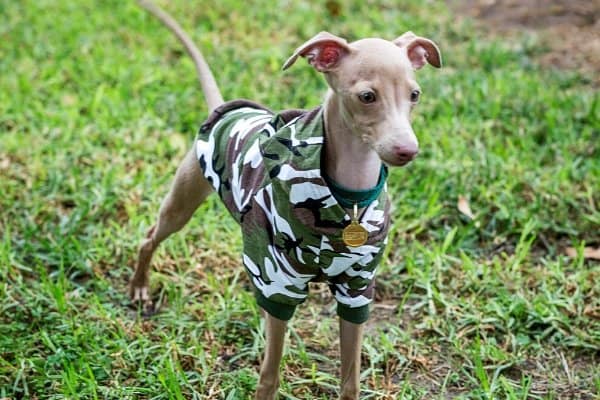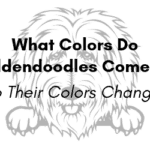If you have been considering the beautiful and delicate Italian Greyhound for your next pet, you may be wondering what colors are available.
Whether you are planning on purchasing a puppy or adopting an older dog, chances are you’ve got a specific color in mind.
What colors do Italian Greyhounds come in? Standard colors are black, seal, sable, cream, blue, red, fawn, red fawn, and blue fawn. Except for cream, these colors may be paired with white. However, all colors are considered acceptable and only two markings are disqualifications in the show ring.
Of course, there is a lot more to a dog than just the color of his coat, and you really can’t go wrong with any color Italian Greyhound. They’re all wonderful!
Learning more about the various color possibilities may help you make up your mind or convince you that you might need more than one Italian Greyhound.
AKC Accepted Colors for Italian Greyhounds
According to the American Kennel Club, any colors and markings in Italian Greyhounds are acceptable. There are two exceptions however.
In the show ring, a dog with either brindle markings or with tan markings typical of black-and-tan dogs of other breeds, such as the Rottweiler, would be disqualified.
The list of accepted colors and patterns for Italian Greyhounds is extensive. There are, however, certain colors that are considered standard for the breed.
Dogs exhibiting nonstandard colors would be registered as an alternate, but still perfectly acceptable, color.
Commonly seen alternative colors include black and tan, blue and tan, brindle, chocolate, and white.
AKC Standard Colors
- Sable – Sable dogs have red hair that is tipped with black. Since Italian Greyhounds have such short coats, the sable effect can be very interesting.
- Seal – Dogs with seal coloration are a shade of brown as dark as nearly black or as light as liver. There is usually a black stripe down the back of the dog and the tail and legs are darker than the rest of the coat.
- Black – Black Italian Greyhounds aren’t easy to find and often have a very sleek appearance.
- Blue – Blue coloring is a dilution of black and gives an overall impression of being an almost metallic blue-gray.
- Fawn – Fawn is a tan color, often a bit darker on the back and occasionally accompanied by a black muzzle.
- Red fawn – Red fawn has similar darker coloration on the back and sometimes on the legs but has a red tint to it.
- Blue fawn – Blue fawn has the same tones as regular fawn but with a blue tint to it.
- Red – Red Italian Greyhounds are a deep, rich color that is a very red shade of brown.
- Cream – Cream is lighter and paler than the fawn color.
Any of these standard colors except for cream may be paired with white in any type of pattern.
Common Patterns
- Solid – Greyhounds with solid coloration are entirely one color, although that color may be darker or lighter over various parts of their body. They may have some white showing on the bottom of the chest, belly, or feet while still being considered solid.
- Irish – This is a white pattern with a collar of white that doesn’t go too far down the legs or onto the head.
- Wild Irish – This is an Irish pattern with the white parts going further up the neck and down the dog’s body.
- Pied – This is one of the more common patterns for Italian Greyhounds. Splashes of any color appear on a white background. The color flashes can be large or small and may cover any part of the body.
- Red with a black mask – This is more or less a red fawn with such a pronounced black mask that it may be considered a pattern.
- Split face – This is a somewhat unusual variation of a pied pattern. Dogs with pied patterns usually have a solid or white head or patches on their face, not a split face
Why are Brindle and Tan Markings Disqualifications?
It can sometimes be challenging to understand why certain colors and patterns are allowed by the AKC and others aren’t.
Often colors are disqualified because they may represent crossbreeding.
It isn’t certain whether that’s the case for brindle and tan-marked Italian Greyhounds, but it is entirely possible.
The larger cousin of the Italian Greyhound, the Whippet, is very often brindle.
Miniature Pinschers as well as Manchester Terriers are both similar in body type to the Italian Greyhound and almost always come in black and tan coloration.
Brindle and black and tan were not found in most Italian Greyhounds as the breed standard was being developed.
The AKC may have decided that excluding these markings from the breed standard would encourage breeders to stay true to the Italian Greyhound and not add additional breeds.
Does an Italian Greyhound’s Color Change?
Italian Greyhounds may see some color variation as they mature. Puppies may become darker or lighter in their base color.
However, Italian Greyhounds do not significantly change color throughout their life.
On the other hand, an Italian Greyhound may become bald, depending on their color (yes, you read that correctly).
Color Dilution Alopecia
Dogs that have dilute pigment, frequently occurring in blue dogs, may develop a condition known as color dilution alopecia.
This genetic condition occurs in many breeds that come in dilute colors, such as the Italian Greyhound.
These dogs are easily distinguished from fully pigmented individuals because their noses, lips, and eyelids are usually flesh colored, blue, lavender, or bluish gray instead of black.
The coat color will also be light, usually a shade of blue, tan, or bronze.
Between about 6 months and 3 years of age, the dog will begin losing hair, especially from areas that have diluted pigment.
It often occurs down the middle of the back and leaves the limbs, tail, and head fully haired. Some individuals may become entirely bald.
In animals that are piebald, white areas may be unaffected while dilute pigmented areas lose hair.
Italian Greyhound Coats
Italian Greyhounds have smooth, silky coats that are extremely short. Coats may tend to be thinner on the stomach and the insides of the legs, especially as your dog gets older.
Their coats are extremely easy to maintain and do not need to be bathed frequently.
The Italian Greyhound is an excellent choice for anyone who wants a small dog with a very low-maintenance coat that they don’t have to worry about grooming or washing frequently.
Most Popular Italian Greyhound Coat Colors
One of the most popular coat colors for Italian Greyhounds is blue. People find this color very unique and interesting.
Because it is actually a dilute form of black, Italian Greyhounds with blue coloring may be more likely to develop color dilution alopecia, so you should carefully consider whether having a blue Greyhound is worth the risk.
If you have your heart set on a blue Italian Greyhound, you may want to adopt one that is over 3 years of age, since the disease process will likely already have taken place if it was going to occur.
Red is a dominant color in Italian Greyhounds, making red a very common color in the breed that does not have risk associated with it and is still quite interesting.
If you can find one, a black Italian Greyhound is very striking and popular.
It can be difficult to tell whether a dog is truly black for the first few weeks of life. It is much more common that the dog will be seal rather than black.
Related Questions:
Do Italian Greyhounds shed?
Italian Greyhounds don’t have much hair but their coat does grow quite quickly and they shed more than you might expect for such a small short-haired breed.
Because there is no undercoat, shedding will not be nearly as extreme as with heavy-coated dogs, but you’ll still likely notice an increase of shed hair in the spring.
Do Italian Greyhounds smell bad?
Italian Greyhounds do not have very active oil glands, which means that they tend to be relatively free from odor.
Unless your Italian Greyhound manages to roll in something stinky, you generally won’t be able to notice a smell from them.
For this reason, Italian Greyhounds do not need to be washed very often. In fact, washing them with soap can dry out their skin so it is best to only wash them with gentle warm water.
Do Italian Greyhounds come in the same colors as Whippets and Greyhounds?
Both Whippets and Greyhounds have a longer list of AKC standard colors than the Italian Greyhound does.
However, in all three breeds, all colors are considered acceptable, so chances are that you’ll find just what you’re looking for in each of the three breeds.





